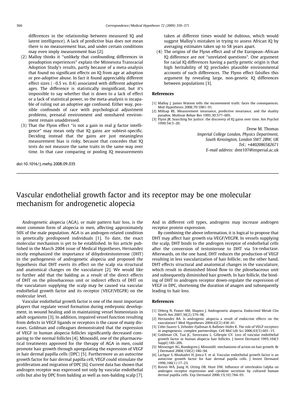TLDR VEGF and its receptor might cause hair loss.
This article suggests that vascular endothelial growth factor (VEGF) and its receptor may be a molecular mechanism for androgenetic alopecia (AGA). Dihydrotestosterone (DHT) binds to androgen receptors in hair follicles, down-regulating the expression of VEGF in dermal papilla cells (DPC), which leads to hair loss. The document also briefly mentions the role of serotonin in viral hepatitis and proposes a modification to the rapid tryptophan depletion (RTD) procedure to potentially reduce virus persistence and immunopathology.
14 citations
,
September 2006 in “Experimental Dermatology” Interleukin‐1 α reduces androgen receptor levels and increases certain cytokines in human scalp cells.
 397 citations
,
February 2004 in “British Journal of Dermatology”
397 citations
,
February 2004 in “British Journal of Dermatology” Minoxidil boosts hair growth by opening potassium channels and increasing cell activity.
 14 citations
,
December 2003 in “Medical Hypotheses”
14 citations
,
December 2003 in “Medical Hypotheses” Male-pattern baldness might be caused by the effect of hormones on scalp blood vessels.
135 citations
,
January 1996 in “Journal of Investigative Dermatology”  47 citations
,
May 1995 in “Journal of Investigative Dermatology”
47 citations
,
May 1995 in “Journal of Investigative Dermatology” Hair follicles in people with alopecia have lower levels of a key blood vessel growth protein.
 May 2025 in “Scientific Reports”
May 2025 in “Scientific Reports” Oxyresveratrol promotes hair growth and may help treat hair loss.
February 2021 in “International journal of regenerative medicine” A new method using fat tissue cells may help treat hair loss.
 October 2025 in “Gene Expression”
October 2025 in “Gene Expression” Exosome therapy could be a promising new way to treat hair loss.
 4 citations
,
September 2020 in “Frontiers in Microbiology”
4 citations
,
September 2020 in “Frontiers in Microbiology” Algal oligosaccharides help prevent hair loss and promote hair growth.
 5 citations
,
March 2018 in “Clinics in Dermatology”
5 citations
,
March 2018 in “Clinics in Dermatology” PRP injections and scalp lifting together improve hair thickness and growth in hair loss patients.
 25 citations
,
May 2020 in “Stem Cells Translational Medicine”
25 citations
,
May 2020 in “Stem Cells Translational Medicine” ADSC-CE treatment safely increases hair density and thickness in androgenetic alopecia patients.








